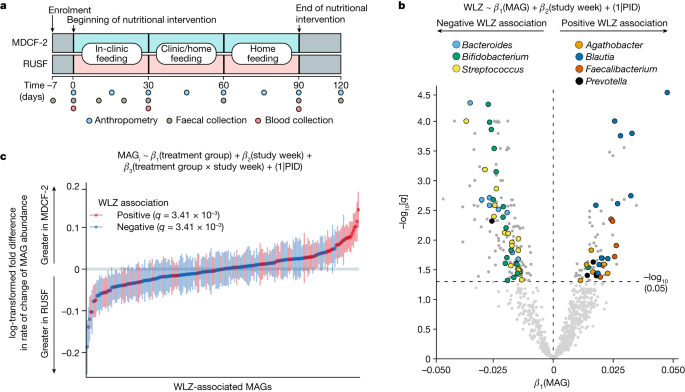2023-12-13 ワシントン大学セントルイス校
◆同じ研究チームによる新しい研究では、この治療食の重要な天然生体化学成分と、これらの成分を処理する重要な腸内細菌株が特定されました。
◆これにより、これらの成分とそれらの治療対象として機能する重要な成長促進の腸内細菌株を特定することが、現行の食品配合での治療を指針とするのに役立ち、将来的にはより効果的な新しい配合の創成が可能になるかもしれません。
<関連情報>
- https://source.wustl.edu/2023/12/gut-bacteria-of-malnourished-children-benefit-from-key-elements-in-therapeutic-food/
- https://www.nature.com/articles/s41586-023-06838-3
- https://www.nejm.org/doi/full/10.1056/nejmoa2023294
栄養失調の子供のための微生物主導型食品に含まれる生物活性糖鎖 Bioactive glycans in a microbiome-directed food for children with malnutrition
Matthew C. Hibberd,Daniel M. Webber,Dmitry A. Rodionov,Suzanne Henrissat,Robert Y. Chen,Cyrus Zhou,Hannah M. Lynn,Yi Wang,Hao-Wei Chang,Evan M. Lee,Janaki Lelwala-Guruge,Marat D. Kazanov,Aleksandr A. Arzamasov,Semen A. Leyn,Vincent Lombard,Nicolas Terrapon,Bernard Henrissat,Juan J. Castillo,Garret Couture,Nikita P. Bacalzo Jr,Ye Chen,Carlito B. Lebrilla,Ishita Mostafa,Subhasish Das,Mustafa Mahfuz,Michael J. Barratt,Andrei L. Osterman,Tahmeed Ahmed & Jeffrey I. Gordon
Nature Published:13 December 2023
DOI:https://doi.org/10.1038/s41586-023-06838-3

Abstract
Evidence is accumulating that perturbed postnatal development of the gut microbiome contributes to childhood malnutrition1,2,3,4. Here we analyse biospecimens from a randomized, controlled trial of a microbiome-directed complementary food (MDCF-2) that produced superior rates of weight gain compared with a calorically more dense conventional ready-to-use supplementary food in 12–18-month-old Bangladeshi children with moderate acute malnutrition4. We reconstructed 1,000 bacterial genomes (metagenome-assembled genomes (MAGs)) from the faecal microbiomes of trial participants, identified 75 MAGs of which the abundances were positively associated with ponderal growth (change in weight-for-length Z score (WLZ)), characterized changes in MAG gene expression as a function of treatment type and WLZ response, and quantified carbohydrate structures in MDCF-2 and faeces. The results reveal that two Prevotella copri MAGs that are positively associated with WLZ are the principal contributors to MDCF-2-induced expression of metabolic pathways involved in utilizing the component glycans of MDCF-2. The predicted specificities of carbohydrate-active enzymes expressed by their polysaccharide-utilization loci are correlated with (1) the in vitro growth of Bangladeshi P. copri strains, possessing varying degrees of polysaccharide-utilization loci and genomic conservation with these MAGs, in defined medium containing different purified glycans representative of those in MDCF-2, and (2) the levels of faecal carbohydrate structures in the trial participants. These associations suggest that identifying bioactive glycan structures in MDCFs metabolized by growth-associated bacterial taxa will help to guide recommendations about their use in children with acute malnutrition and enable the development of additional formulations.
栄養不良の子供のための微生物叢指向食品介入 A Microbiota-Directed Food Intervention for Undernourished Children
Robert Y. Chen,Ishita Mostafa,Matthew C. Hibberd,Subhasish Das,Mustafa Mahfuz,Nurun N. Naila,M. Munirul Islam,Sayeeda Huq,M. Ashraful Alam,Mahabub U. Zaman,Arjun S. Raman,Daniel Webber,Cyrus Zhou,Vinaik Sundaresan,Kazi Ahsan,Martin F. Meier,Michael J. Barratt,Tahmeed Ahmed,and Jeffrey I. Gordon
The New England Journal of Medicine Published:April 22, 2021
DOI:DOI: 10.1056/NEJMoa2023294

Abstract
BACKGROUND
More than 30 million children worldwide have moderate acute malnutrition. Current treatments have limited effectiveness, and much remains unknown about the pathogenesis of this condition. Children with moderate acute malnutrition have perturbed development of their gut microbiota.
METHODS
In this study, we provided a microbiota-directed complementary food prototype (MDCF-2) or a ready-to-use supplementary food (RUSF) to 123 slum-dwelling Bangladeshi children with moderate acute malnutrition between the ages of 12 months and 18 months. The supplementation was given twice daily for 3 months, followed by 1 month of monitoring. We obtained weight-for-length, weight-for-age, and length-for-age z scores and mid–upper-arm circumference values at baseline and every 2 weeks during the intervention period and at 4 months. We compared the rate of change of these related phenotypes between baseline and 3 months and between baseline and 4 months. We also measured levels of 4977 proteins in plasma and 209 bacterial taxa in fecal samples.
RESULTS
A total of 118 children (59 in each study group) completed the intervention. The rates of change in the weight-for-length and weight-for-age z scores are consistent with a benefit of MDCF-2 on growth over the course of the study, including the 1-month follow-up. Receipt of MDCF-2 was linked to the magnitude of change in levels of 70 plasma proteins and of 21 associated bacterial taxa that were positively correlated with the weight-for-length z score (P<0.001 for comparisons of both protein and bacterial taxa). These proteins included mediators of bone growth and neurodevelopment.
CONCLUSIONS
These findings provide support for MDCF-2 as a dietary supplement for young children with moderate acute malnutrition and provide insight into mechanisms by which this targeted manipulation of microbiota components may be linked to growth. (Supported by the Bill and Melinda Gates Foundation and the National Institutes of Health; ClinicalTrials.gov number, NCT04015999. opens in new tab.)

